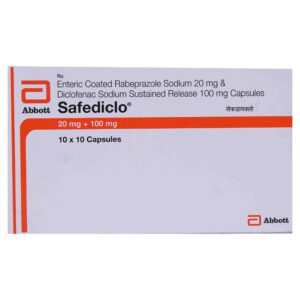DICLOFENAC + RABEPRAZOLE
Diclofenac: Diclofenac is a nonsteroidal anti-inflammatory drug (NSAID) that is commonly used to relieve pain, reduce inflammation, and treat conditions such as arthritis, gout, and ankylosing spondylitis.
The drug works by inhibiting the production of certain chemicals called prostaglandins in the body. Prostaglandins are responsible for causing inflammation, swelling, and pain. By reducing their production, diclofenac helps to alleviate these symptoms.
Diclofenac is available in various forms, including tablets, capsules, gels, patches, and injections. The appropriate dose and frequency of administration depend on the specific condition being treated and the formulation of the drug. It is commonly taken orally with or without food.
As with any medication, diclofenac can cause side effects. Common side effects include stomach pain, nausea, diarrhea, indigestion, and dizziness. In some cases, it may also cause more serious side effects such as stomach ulcers, bleeding, liver damage, and allergic reactions. It is important to discuss any symptoms or concerns with a healthcare professional.
Diclofenac may interact with other medications, so it is essential to inform your healthcare provider about all the drugs you are taking, including over-the-counter medicines and herbal supplements. Individuals with certain medical conditions, such as heart disease, kidney problems, or a history of stomach ulcers, may need to use diclofenac with caution or avoid it altogether.
It is important to note that diclofenac is available by prescription or over-the-counter, depending on the country. Always follow the recommended dose and instructions provided by your healthcare provider or on the product packaging.
Rabeprazole: Rabeprazole is a medication that belongs to a class of drugs known as proton pump inhibitors. It is primarily used to treat conditions related to an excessive production of stomach acid such as gastroesophageal reflux disease (GERD), peptic ulcers, and Zollinger-Ellison syndrome.
The main mechanism of action of rabeprazole involves reducing the amount of acid produced in the stomach by inhibiting the proton pump enzyme within the gastric cells. This helps to alleviate symptoms associated with excessive stomach acid, such as heartburn, acid regurgitation, and stomach pain.
The typical dose of rabeprazole for various conditions may vary depending on the individual and their specific needs. For GERD, the recommended dose is 20mg once daily for 4 to 8 weeks. For the treatment of peptic ulcers, the standard dose is usually 20mg once daily for a period of 4 weeks.
Like any medication, rabeprazole may cause side effects. Common side effects may include headache, stomach pain, diarrhea, and nausea. Other less common side effects that may occur include dizziness, skin rash, itching, and increased liver enzymes. It is important to consult a healthcare professional if any of these side effects are experienced, as they can provide guidance and advice on how to manage them.
As with any medication, it is essential to follow the prescribed dosage and duration of treatment advised by a healthcare professional. It is also recommended to let your healthcare provider know about any other medications or medical conditions you have before starting rabeprazole, as it may interact with certain drugs or exacerbate certain conditions.

